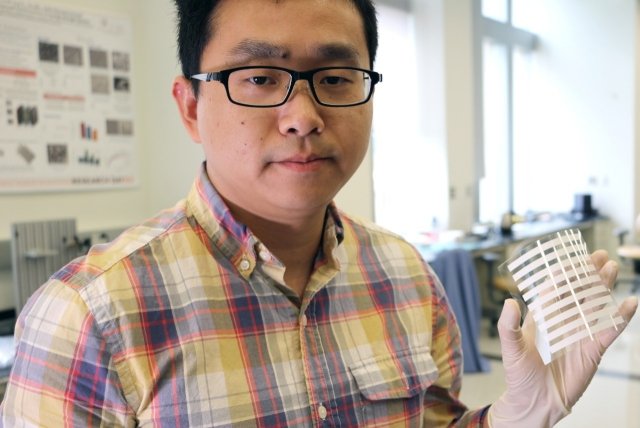A flexible solar panel that can be used as blinds or wallpaper

Solar cells that convert light into electrical energy, play an important role in stimulating production of solar energy in the world. However, researchers still face restrictions that prevent increased prevalence of this technology. Improving the efficiency of the batteries remains an urgent task. Scientists around the world have not abandoned their attempts to create a compact, easy-to-use and low-cost technology that could benefit everyone. Some researchers have promised that in the near future processing of light energy in your home become simple and ordinary procedure. Led by Shashank Priya, a team of mechanical engineers and chemists at Virginia Tech produces flexible solar panels, which are obtained from window blinds or wallpaper to capture solar energy and sources inside buildings.
Solar modules of less than half a millimeter in thickness are created by screen printing at low temperature. Part of a five-layer structure of flexible material - the titanium oxide paste. The result is a thin, flexible panels, similar to the tiles in the bathroom. These tiles can be joined together to cover large areas of them. One panel the size of a human palm provides about 75 milliwatts of power. Scientists suggest that from a panel the size of a normal sheet of A4 will be enough to easily charge your smartphone.
The work of Priya and his team described in the article, published in the June issue of ACS Energy Letters. Engineers promise that their panel grab a wide range of light waves that will produce energy by installing special blinds. Another work showing the stability of the plates, will be published later in the same journal.
To date, flexible panels in their effectiveness a little smaller than a hard and rigid silicon, and Priya says that more research is still needed. However, it is likely that the new flexible panels will soon catch up with their more rigid "brothers".
Conventional silicon cells that are advertised in terms of efficiency as the gold standard industry for over a decade, are relatively cheap. Efficiency of converting sunlight into electricity is 15-20%. Priya panels provide about 10% efficiency in the standard size. The smaller the size, the greater the efficiency, so the researchers see the potential for a much more effective energy collection.
World record efficiency for the multijunction solar cell belongs to two French companies - Soitec and CEA-Leti, which together have 46% in December 2014 with the Institute for Solar Energy Systems Fraungover. Previous record in this area (44.7%) also belongs to the association of institutes and companies, with the participation of Helmholtz-Zentrum Berlin.
Most silicon panels can only absorb sunlight. Flexible panels are designed so that they can absorb ambient light, for example, LEDs, incandescent and fluorescent lamps.
The technology is attractive for several reasons. Firstly, for the manufacture of the modules do not require high temperature and the manufacturing equipment is relatively inexpensive and easy to use. Secondly, there is the opportunity to create a miniature panel, which will be charged on all sorts of devices in the home, and the whole leaf rolls, which can paste over the whole room and used for energy and heating. From the obtained panels blinds or curtains, which will absorb light through the windows. Properties panels are such that they really are very few restrictions in terms of light sources.
Since the flexible panels are close to solid conversion efficiency of silicon and glass, can be used where the old technology could not be competitive. For example, in military uniforms and backpacks. Now Priya laboratory collaborates with the Research center for electronics and communications of the American army (CERDEC). If you add the flexible panel to these things, the soldiers themselves will be walking the station for recharging. This will help reduce the amount of wearable material and technical equipment and to reduce the weight of each individual soldier carries on his back.
"Right now we are at the forefront of this technology. We are able to produce large-area modules with high efficiency and are actively working to bring our product to market. We see a wide range of applications of this technology: from clothing to windows in the smart homes of unmanned aerial vehicles to mobile charging stations "- says Priya.
DOI: 10.1021/aksenergolett.shv00457
Referenced Materials:
- http://pubs.acs.org/doi/abs/10.1021/acsenergylett.6b00215
- https://en.wikipedia.org/wiki/Helmholtz-Zentrum_Berlin
- https://www.ise.fraunhofer.de/en/press-and-media/press-releases/press-releases-2014/new-world-record-for-solar-cell-efficiency-at-46-percent
- https://www.ise.fraunhofer.de/en/press-and-media/press-releases/presseinformationen-2013/world-record-solar-cell-with-44.7-efficiency
- https://en.wikipedia.org/wiki/United_States_Army_Communications-Electronics_Research,_Development_and_Engineering_Center
- http://pubs.acs.org/doi/abs/10.1021/acsenergylett.6b00457
Once again, the source is here. Please stop plagiarising and write good original posts again!
Gotta love Technology!
Thank you for the information...re-steeming.
You're welcome.
Interesting article, thank you.
My daughter is currently working on solar solutions in material chemistry at college.